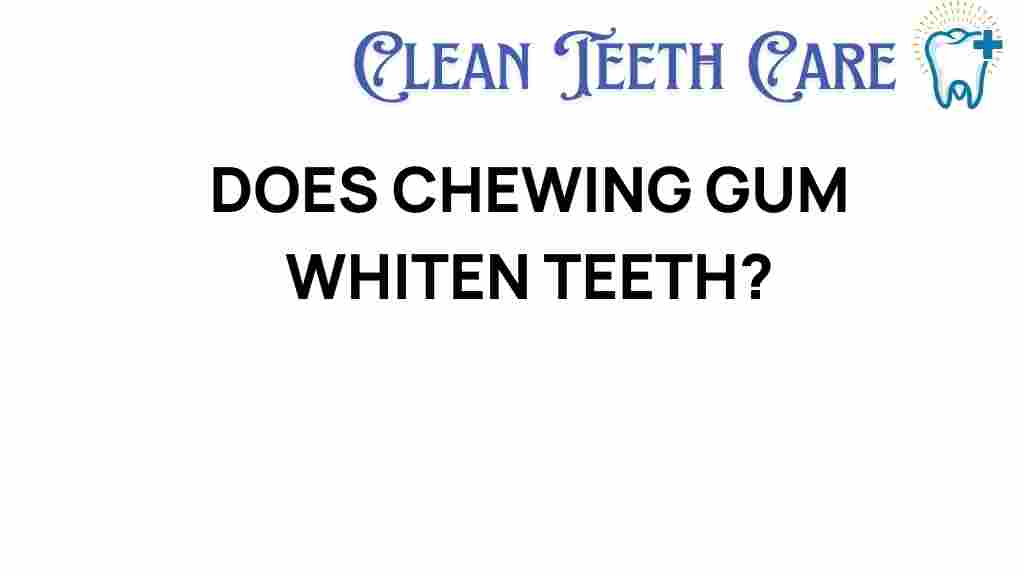Unraveling the Truth: Does Chewing Gum Whiten Teeth?
When it comes to maintaining a bright smile, many people wonder about the effectiveness of various methods for teeth whitening. One common question is whether chewing gum can help keep teeth white and enhance dental health. In this article, we’ll explore the relationship between chewing gum and teeth whitening, debunk some common myths, and provide insights on how to achieve optimal oral hygiene for a radiant smile.
The Science Behind Chewing Gum and Teeth Whitening
Chewing gum, especially sugar-free gum, has been touted for its potential benefits to dental health. But how does it really impact the whiteness of your teeth? Let’s delve into the science.
- Saliva Production: Chewing gum stimulates saliva production, which can help wash away food particles and neutralize acids in the mouth. This increased saliva flow can contribute to better overall oral hygiene.
- Surface Stains: While chewing gum may help remove some surface stains, it doesn’t actively whiten teeth. The abrasiveness of certain gums can aid in polishing the enamel, but it won’t penetrate the tooth structure to change its color.
- Fluoride Benefits: Some gums are infused with fluoride, which can strengthen tooth enamel and help protect against decay, indirectly contributing to a healthier smile.
Myth-Busting: Chewing Gum and Teeth Whitening
There are several myths surrounding the use of chewing gum for teeth whitening. Let’s clarify these misconceptions:
- Myth 1: Chewing gum can replace toothpaste.
Reality: While chewing gum can help maintain fresh breath and clean teeth temporarily, it is not a substitute for proper brushing with toothpaste and flossing. - Myth 2: All chewing gums whiten teeth.
Reality: Only specific brands that contain whitening agents can lighten tooth color. Most chewing gums do not have this capability. - Myth 3: Chewing gum can repair enamel.
Reality: Chewing gum can help protect enamel but cannot repair it. Once enamel is damaged, it cannot be restored, which is why maintaining good oral hygiene is essential.
How to Use Chewing Gum for Better Oral Health
If you’re looking to incorporate chewing gum into your dental health routine, here are some tips:
- Choose Sugar-Free: Always opt for sugar-free gum to avoid contributing to tooth decay. Sugar can lead to cavities, negating any benefits gained from chewing gum.
- Look for Added Benefits: Some gums contain xylitol, which can inhibit the growth of bacteria that cause cavities.
- Chew After Meals: Chewing gum after meals can help reduce acidity in the mouth and promote saliva flow, aiding in the natural cleaning of teeth.
Step-by-Step Process to Achieve Whiter Teeth
While chewing gum has its benefits, achieving a brighter smile typically requires a multifaceted approach:
1. Maintain a Regular Oral Hygiene Routine
Brush your teeth at least twice a day with fluoride toothpaste and floss daily. This foundational step is crucial for preventing stains and maintaining healthy enamel.
2. Consider Professional Teeth Whitening
If you’re serious about teeth whitening, consult with your dentist about professional whitening options. These treatments are more effective than over-the-counter products.
3. Use Whitening Toothpaste
Incorporate a whitening toothpaste into your routine. These toothpastes contain mild abrasives and special chemical agents designed to help remove surface stains.
4. Limit Staining Foods and Drinks
Avoid or limit consumption of foods and drinks that can stain teeth, such as:
- Coffee and tea
- Red wine
- Dark berries
- Sodas
5. Stay Hydrated
Drinking water throughout the day helps wash away food particles and bacteria that can lead to staining and decay.
6. Chew Sugar-Free Gum
As mentioned previously, chewing sugar-free gum can help maintain fresh breath and reduce acidity in the mouth after meals.
7. Regular Dental Check-ups
Schedule regular appointments with your dentist for cleanings and check-ups. Professional cleanings can remove tartar and stains that regular brushing may miss.
Troubleshooting Tips for Common Dental Issues
Even with a good routine, you may encounter some common dental issues. Here are some troubleshooting tips:
- Stains Persisting: If stains remain despite your efforts, consult a dentist about professional whitening treatments.
- Tooth Sensitivity: If you experience sensitivity while using whitening products, reduce usage and speak to your dentist for alternatives.
- Bad Breath: If bad breath persists despite chewing gum, it may be a sign of an underlying issue, such as gum disease. Consult your dentist.
Conclusion: The Role of Chewing Gum in Oral Hygiene
In conclusion, while chewing gum can play a supportive role in maintaining oral hygiene and promoting dental health, it is not a standalone solution for teeth whitening. Myths surrounding its effectiveness should be debunked, and a comprehensive approach to teeth whitening should be adopted. By following a consistent oral care routine and utilizing the benefits of sugar-free gum, you can contribute positively to your dental health and enjoy fresher breath.
For further reading on maintaining a bright smile, check out this comprehensive guide on dental care.
Finally, remember that the best way to achieve and maintain a bright smile is through a combination of good habits, including proper brushing, flossing, and regular dental visits.
This article is in the category Treatments and created by CleanTeethCare Team
